There are many different antifreeze formulations out there in the wild and wooly real world, but for the Mercedes-Benz service specialist who cares about his customers there’s only one real choice.Â
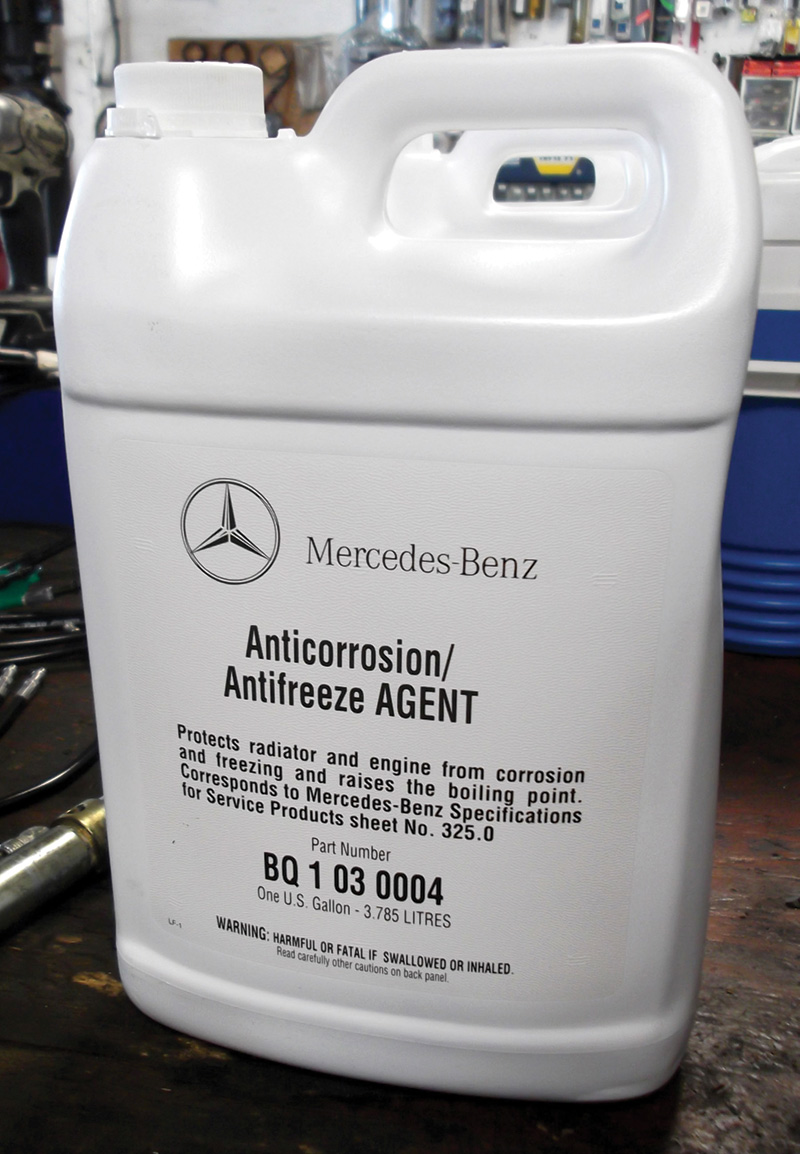
The current blue-dyed formula carries the part number BQ 1 03 0004, which is also designated as G48. It only comes full-strength, not pre-diluted. The previous yellow-tinted antifreeze is no longer available.
“One size fits all†generic antifreezes that claim to meet every automaker’s specs aren’t what Mercedes-Benz engineers had in mind when they designed the company’s cooling systems. Whenever you see the word “compatible†on a jug no matter how reputable the brand, remember that that doesn’t mean equal protection. All it signifies is that no “battleground†issues (somewhat similar to harmful drug interactions) that can quickly cause metal damage have shown up in laboratory tests.
As a preliminary, we should mention that all original equipment antifreezes and most aftermarket brands are 93-95% ethylene glycol and diethylene glycol, 3-5% rust/corrosion inhibitors, plus about 2-3% water and/or solvent (required to keep the rust/corrosion inhibitors in solution), and a leak-trace dye. A few aftermarket antifreezes are made with propylene glycol, which is promoted as less toxic, but which is not quite as effective at freeze protection.Â
Green, yellow, blue
A look at the evolution of Mercedes-Benz “Anticorrosion/Antifreeze AGENT†(as it says on the label) will give you a better understanding of what you should use either for a simple topping up after replacing a hose or water pump, or for a complete flush and refill service. In the U.S., the cooling systems of all domestic cars and many imports used “conventional green†since the inception of “permanent†antifreeze, as opposed to the plain alcohol that had been employed previously to prevent cracked blocks (it tended to boil off). The inhibitors in this obsolete mixture are sodium silicate and phosphate, both proven protectors for aluminum, benzoate and borate for broad-range metal protection, and triazole for old-fashioned copper-brass, plus an inhibitor that keeps cast iron from rusting (not much of that to be found in engines anymore). It worked pretty well, but had to be flushed out and replaced every couple of years.
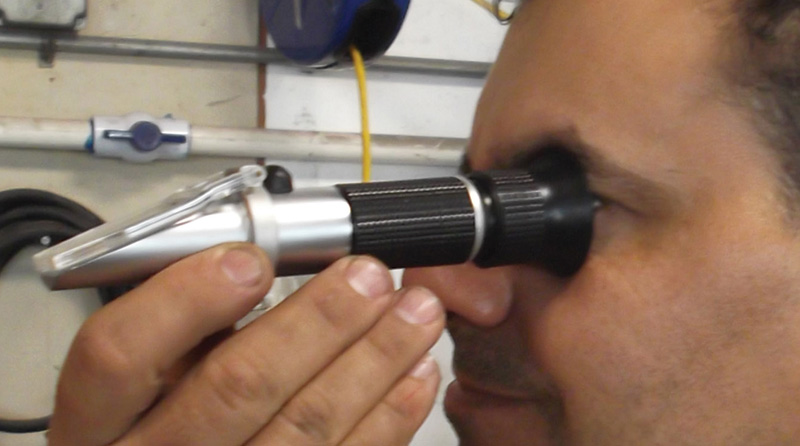
If a cooling system has been topped up with plain water to compensate for a slow leak, or when a part was replaced, obviously the concentration of antifreeze and its important inhibitors will be too low. So, always check it during routine maintenance, preferably with a refractometer.
Mercedes-Benz, on the other hand, has for many decades filled its systems with the yellow antifreeze you’re surely familiar with ((Part Number Q 103 0002, spec sheet number 325.0, and designated G05). The jug states that it contains ethylene glycol, diethylene glycol, sodium tetraborate, sodium benzoate, corrosion inhibitors, defoamers, silicates, and dyes. This has shown to be an excellent product, and it qualifies as a HOAT (Hybrid Organic Acid Technology), though light on organic acids. Instead of the phosphate corrosion inhibitors some manufacturers add to their antifreeze, which can lead to harmful deposits in the cooling system, Mercedes-Benz opted for silicates. These give immediate corrosion protection, whereas with pure OATs considerable time is required before a coating is established (5,000 miles is typically quoted). Silicates are also the best defense against what’s called “water pump cavitation erosion-corrosion.â€Â The only negative characteristic we know of about them is that they can drop out of solution over a shorter time than would qualify for the “long-life†classification that was becoming all the rage.
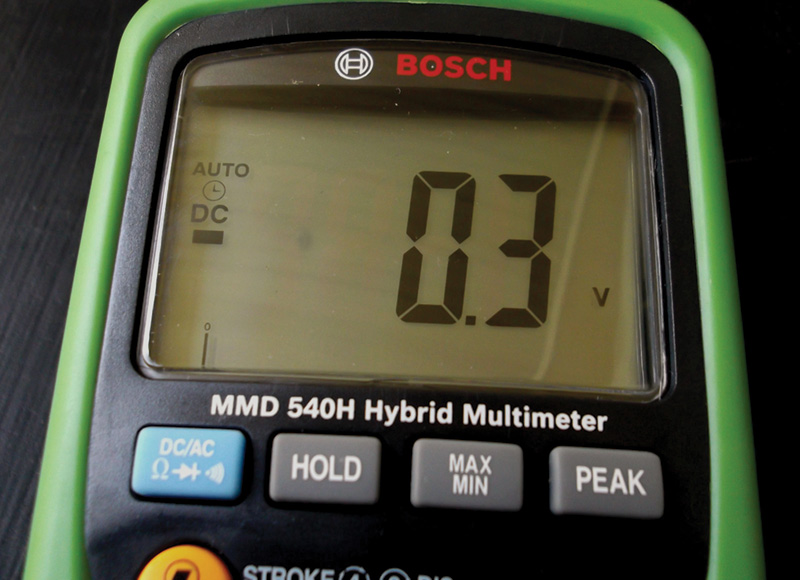
Any voltage reading between the coolant and ground means that electrolysis has started, which can result in expensive damage. Flush and refill with the right stuff.
Mercedes-Benz adopted an ingenious and unique answer to this problem that allowed the15-year/150,000-mile change interval to be recommended starting in 2002: a packet of silicate gel built into the coolant overflow tank. Somewhat similar to the little envelopes of silica that are used in the packaging of various products as a desiccant, it serves as means of continuous rejuvenation of the corrosion-protection qualities of the antifreeze. Laboratory tests have shown that even up to 15 years, most of the inhibitor remains in the gel, still available to add protection.
Better yet
About five years ago, Mercedes-Benz started the switch from the G05 used for as long as most of us can remember to the blue-dyed HOAT (Hybrid Organic Acid Technology) G48, Part Number BQ 103 0004. The Tuscaloosa plant adopted it in 2010, and by 2012 MBUSA aftersales offered nothing else. The only significance of the color is to differentiate one formulation from the other.
The new blue product is slightly different in that it adds more organic acid, along with its basic silicate additive. It’s a worthwhile evolutionary improvement, but is still rated as having a 15 year/150,000 mile life (that’s not long enough?). There’s no better protection from corrosion, erosion, deposits, and gelling.
According to the label, it contains ethylene glycol, diethylene glycol, sebacic acid, sodium hydroxide, 2-ethylhexanoic acid, corrosion inhibitors, defoamers, silicates, dyes, and a bittering agent. Its ASTM spec is D3306.
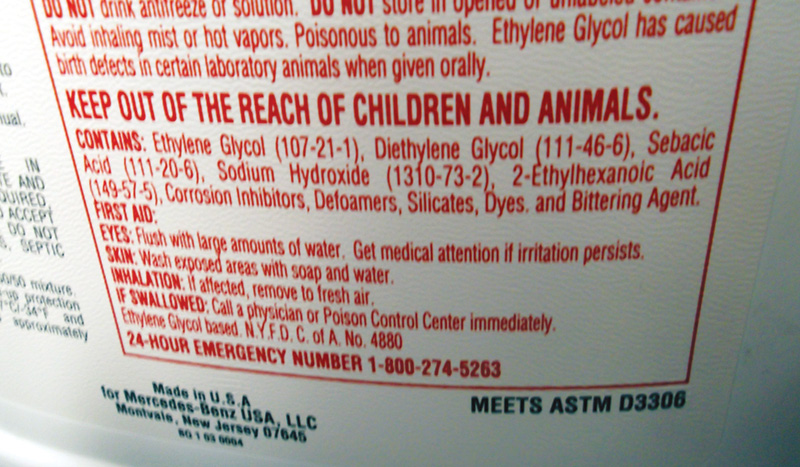
While the previous formula qualified as a HOAT, the new one is more so with additional organic acids that assure even better protection.
Fortunately, the yellow-dyed G05 formula is 100% compatible with the pretty new blue stuff. So, if you replace a water pump, hose, or a head gasket, you don’t have to do a complete coolant flush and replace. Certainly, it would be a good idea to broach this sensible maintenance practice to your customers, but it’s not absolutely necessary.
Will adding blue to yellow make a horrible-looking muddy mess in the radiator’s filler neck? Not really. According to basic color theory, the primary colors yellow and blue when blended in equal proportions produce green. Not a problem, and that’s what you should expect.
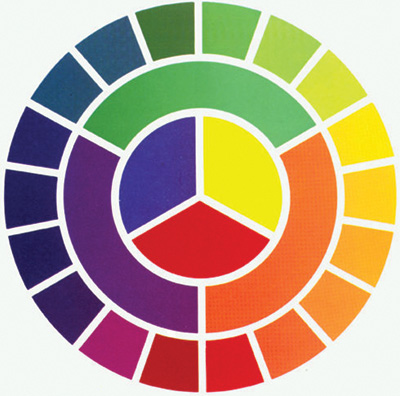
According to basic color theory, mixing the new blue with the previous yellow-tinted formula in equal proportions will produce a nice green. They are completely compatible.
The new M-B antifreeze is even longer-lasting than that which you’ve been using for many years. Embrace it, and be happy that the cost isn’t much more (the same as that of the previous yellow) than if you had substituted some dubious generic that claims to meet M-B specs.Â
Given the “green†age we’re now living in, you might have suspected that there’s an environmental component to the industry-wide switch to long-life antifreeze, and you’d be right. In Europe and the U.S., the concern is that do-it-yourselfers typically just dump old coolant down the drain, or even right on the ground, which contaminates the water table. So, the longer it can be kept in service, the less of it will find its way into the environment.
More on phosphates

Is tap water okay for the 50/50 blend? Most regions in the U.S. have “hard†water, meaning it contains mineral and metallic particles, primarily calcium and magnesium, to the tune of 120 ppm and up. Also, particularly in the South, many municipalities add so much chlorine to city water that you can smell it. In either case, you’re asking for problems in the long term.
We mentioned phosphates above, and that brings up two additional points. First, this form of protection, which is especially popular among Asian car makers, doesn’t react well with the minerals found in hard water, tending to form heavy deposits that can limit, or even block, coolant flow through small passages. Mercedes-Benz made the decision to go with silicates partially because its vehicles are sold worldwide, and there’s no telling what the qualities of local water might be everywhere.
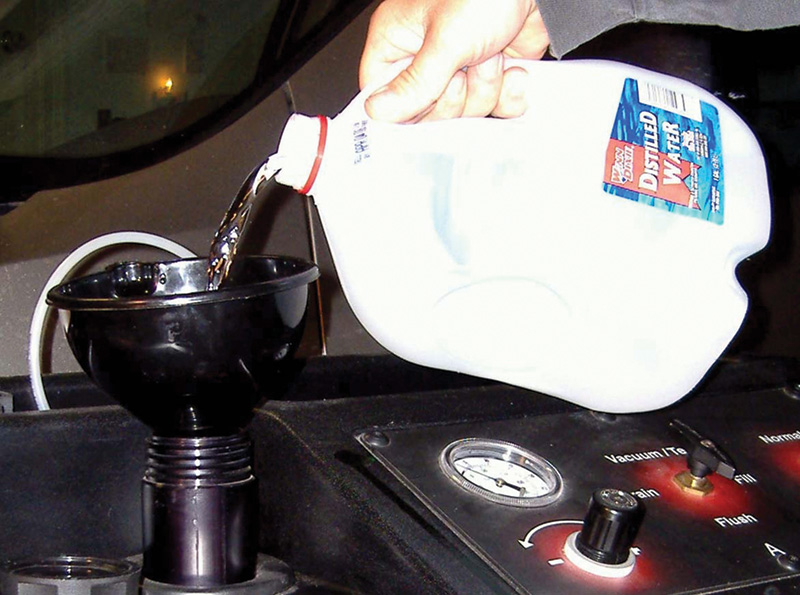
You can differentiate yourself from your competitors by advertising that you use only distilled or de-ionized water (at maybe $1 per car) and genuine Mercedes-Benz antifreeze in cooling systems.
Second, you might be thinking that it’s okay to use any antifreeze in a Mercedes-Benz as long as it doesn’t contain phosphates, a pure OAT, for instance. Think again. The factory fill will have established a specific type of corrosion protection mechanism. A different type of inhibitor package will not continue with that form of protection and might even cancel it out. Another problem with pure OATs, by the way, that most technicians who work on domestic cars are familiar with, is that they only offer protection to surfaces that are continuously immersed. If the coolant level should ever be allowed to drop, truly catastrophic corrosion will begin very quickly. Silicates, on the other hand, “paint†all those vulnerable interior surfaces with a long-lasting coating that works even if air is present.
Approved, but not practical
Over the years, Mercedes-Benz has tested many high-quality brands of antifreeze to find out which ones can be classified as Factory Approved Service Products, but looking at the list of similar silicated HOATs might give you a chuckle. Where are you going to find Fricofin Kühlerfrostschutz (made in Germany), Agip Antifreeze Plus (Italy), Dragon Power Coolant (S. Korea), or Behran Zagros (Iran)?
Doesn’t it make more sense to just buy genuine M-B antifreeze from the dealer where you make most of your parts purchases? The somewhat higher price than that of a questionable generic makes next to no difference in the overall cost of vehicle ownership, and may, in fact, head off very expensive repairs.
As the company’s service literature states, “Failure to use M-B Anti-corrosion/Antifreeze may result in a significantly shortened service life. While there may be a number of products available which will provide the required protection, all such products have not been tested for Mercedes-Benz vehicles.â€
H2O plus?
Everybody in the auto service business should be giving more thought to the other component of coolant: water. Mercedes-Benz service info states that antifreeze should be blended with water “that is not too hard.â€Â That’s not very specific, so we here at StarTuned believe an explanation is in order.
First, “hardness†refers to the water’s content of mineral and metallic particles, primarily calcium and magnesium, but also iron. The measurement scale starts at 17 parts per million, and any number over 120 ppm is considered hard, but wells in some areas of the country yield up to 850 ppm!
Even though silicated HOAT is much better at tolerating these particles than other types of antifreeze, they still amount to contamination.
Also, in many places city water contains so much chlorine you can smell it. Using it in a cooling system would be introducing an unwanted reactant.
So, we suggest that unless you have a water softener, you purchase distilled or de-ionized H2O to make the mix. This is actually a good way to take your shop’s reputation to the next level and differentiate yourself from your competitors at practically no cost. Advertise that you use nothing but distilled water and genuine original-equipment Mercedes-Benz antifreeze in the cars you service.  Â
Points
We’ll conclude with some random, but important, points:
- Symptoms of a neglected cooling system today may include a MIL-On, and the OBD II Code P0128, which indicates a failure to reach normal operating temperature in a specified time.
- We hope you realize that Mercedes-Benz’s incredible long-life service interval is predicated on a properly maintained system. If the coolant mix is kept at 50/50 (at least — you can go somewhat higher in antifreeze concentration), and the level is never allowed to fall, they apply. If not, there are no guarantees that damage won’t result. If you change to an antifreeze with inhibitors that provide a different type of protection (such as phosphates or organic acids), continued protection may be compromised.
- Then there’s the case of the second cooling system. The Mercedes-Benz 6L V12 Bi- Turbo has a separate circuit for its twin turbochargers. Although the engines themselves carry the 15/150 service interval, the second system should be flushed and refilled every four years.
- If you’re ever tempted to top off the system with an antifreeze that has some other type of inhibitor package than that of the Mercedes-Benz factory fill, resist. If it uses phosphates or OAT, you’ll lose the benefit of the silica gel packet. Under severe conditions, such as a low antifreeze concentration, there might not be enough of the needed additives to prevent corrosion. To put it another way, you’re contaminating the factory fill. Neither inhibitor package may be strong enough to provide its specific type of protection.
- Generic antifreeze producers may claim that if you drain the cooling system, you avoid any performance issues when you switch coolants. That’s not necessarily true with a Mercedes-Benz. Specific silicate protection has been established, and the system is designed for continued refreshment from the silicate packet. Further, it’s difficult to completely drain the system, although use of good coolant exchange equipment should remove maybe 90% of the old stuff.
- By volume, a 50% concentration of genuine Mercedes-Benz antifreeze will keep the icebergs away down to -35 deg. F. A higher concentration is only necessary if the ambient temperatures are even lower. Going to 55% gives you -49 deg. F. If you live where it gets colder than that, move.
- Although one engineer has told us that you can go as high as 70/30, Mercedes-Benz service literature states that a concentration of more than 55% antifreeze should not be used as the maximum freeze protection has already been reached.
- Higher concentrations impair heat transfer.
- It wouldn’t hurt to read what http://bevo.mercedes-benz.com says about coolant, and fluids in general. For English, go to the link at the very bottom of the page.
- Pure OATs are so potentially troublesome that one major producer found itself in trouble with the FTC over its advertising claim that its antifreeze was “universal†and could be safely used in any make vehicle. So, “Big Name†doesn’t necessarily mean “reputable.â€


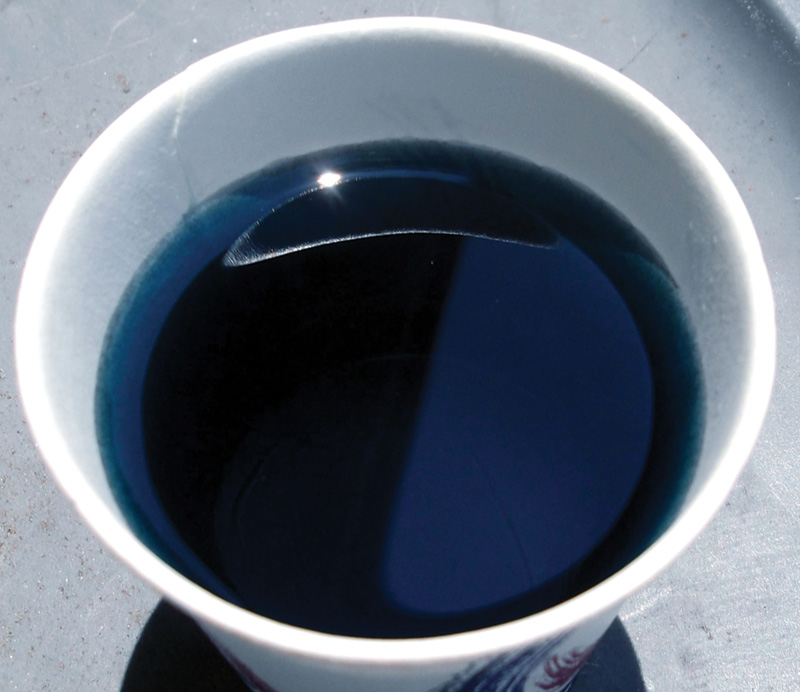




0 Comments